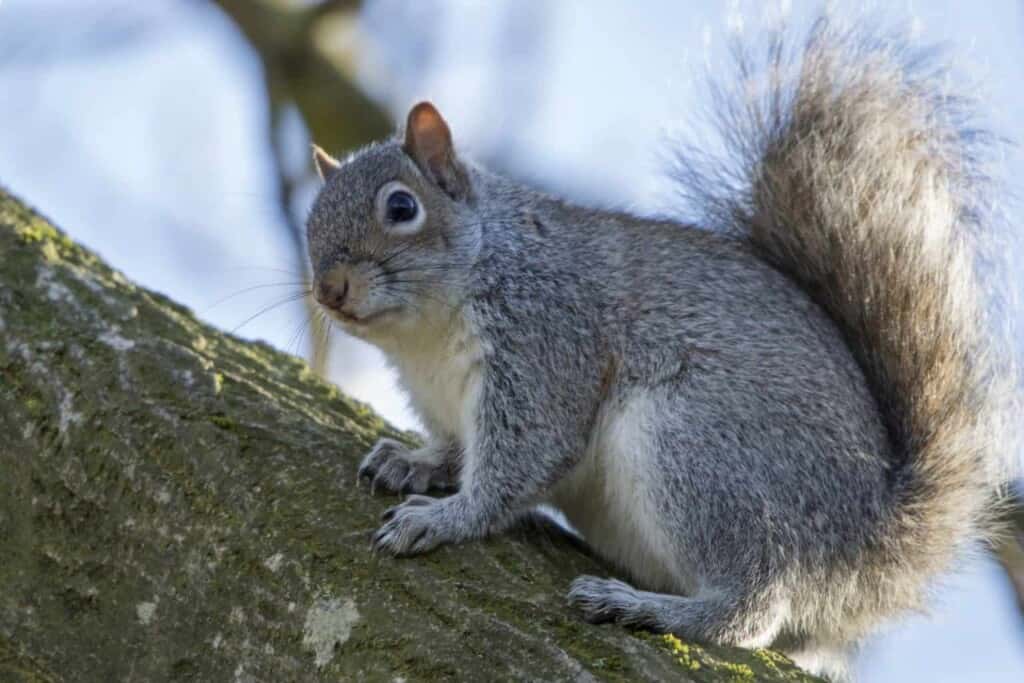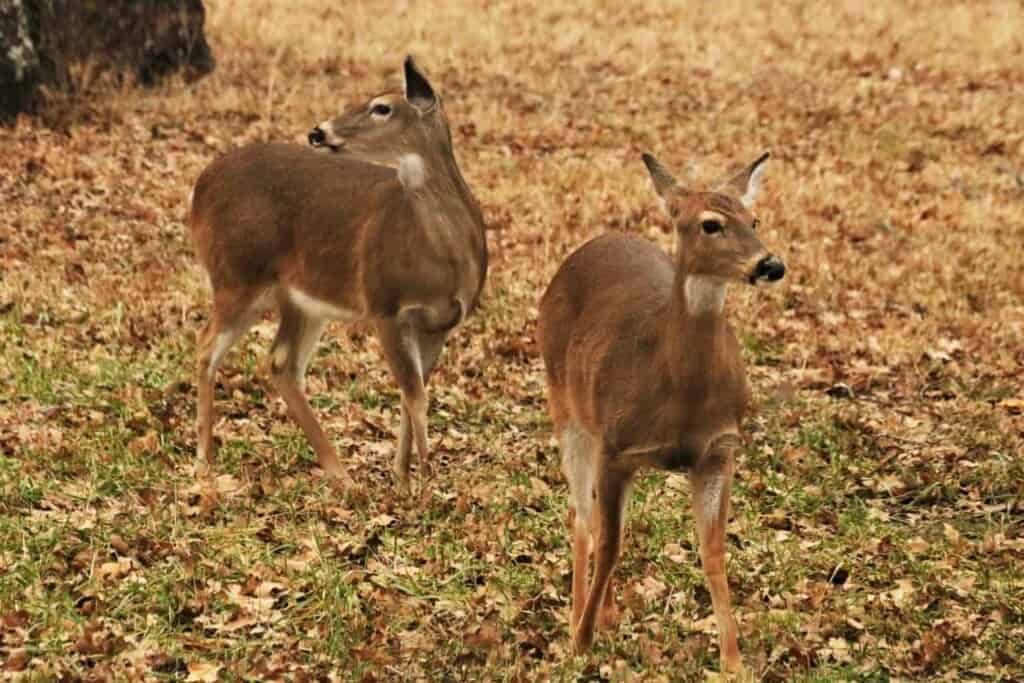Learning when a deer is coming is possibly the most useful skill a hunter can acquire. Every hunter has been fooled by a pesky squirrel or looked up to see a ninja-like deer staring at them just 15 yards away. It can take decades for a hunter to master this skill. In fact, many hunters still struggle with interpreting the natural signs given in the woods when a deer is coming. Here, I will go over everything I have learned in my experience and research, and show you what to look and listen for while deer hunting. Practicing this invaluable skill is a necessity and will put you on your way to becoming a better hunter.
What To Look & Listen For
The Evil Squirrels
The bane of any hunter eager to spot a deer is the famously noisy squirrel. Most times you can tell the difference between deer and squirrels by the frequency that they move. Squirrels will sporadically move about and cause a lot of noise when they are chasing other squirrels. Singular squirrels will be more confusing, they will hop around and thrash through the leaves with an irregular pattern. This can make them sound like a deer to the untrained ear. Once you have heard it enough times you can tell that a squirrel sounds lighter on the leaves and that the frequency of movement does not quite line up with what we expect from a deer.

Although squirrels are not all bad, they can actually help us in the woods as well. Squirrels will bark and sound an alarm at nearly anything that moves in the woods. This is very annoying when it is you that they are barking at, but occasionally they leave you alone. When squirrels are barking, pay attention to the movement in the area, you will probably see another animal of some sort. As long as there are not any hawks or owls flying around, you may see a deer, turkey, coyote, or bobcat.
Bird Signs

Birds are very useful in the woods, they scare easily and make all sorts of noises, each with a different meaning. I normally pay the most attention to crows in the woods. They are normally in groups (murders) and you can easily tell when they have been spooked by something. They will also make many alert calls before actually taking off and be sure to make plenty of noise while taking off and flying. If you pay attention, you will notice this type of behavior in many bird different species. Many hunters actually cite blue jays as being a reliable tattletale for whitetail and other movements. Just like any other facet of hunting, everyone has their own methods or ideas they believe, and in this case, none of them are wrong. Crows, blue jays, or whatever it is can help.
Keep in mind that just because birds are making noise or taking off does not always mean there is something there. Either way, it is possible and worth looking in that direction. There is not really a 100% accurate sign that a deer is coming until you figure out exactly what they sound like walking.
Reading Other Deer
Deer are the ultimate sentry for other deer. I know this sounds like a paradox that you need a deer to see a deer, but after you already have one deer show up and you do not plan on harvesting it, you should pay attention to its body language. Deer have much better senses than we do. We do not rely on our senses to hunt deer but instead, we use our brains. If it were the other way around we would almost never be successful.
You need to pay attention to where the deer is looking and how its ears are oriented. Deer obviously look in the direction where they think something is but they will also orient their ears in the direction they hear something when they are feeding. This is especially prevalent during the rut. Does are chased all day and night but if you get a lone doe in front of you she will be extra skittish. Her body language will be an obvious sign of when a buck is coming.
Interpreting Sounds of Movement
When you hear the sound of something moving through the leaves, it can be many different things. There is really no exact way for me to tell you the difference in pitches and frequencies of all the different sounds animals make when moving around. It really just takes practice. Over the years you will learn the difference between the sporadic and high-frequency of shuffles that a bird or squirrel makes versus the rhythmic steps of a deer.
Even deer themselves make many different noises while moving around. Many times you will hear a rhythmic stepping or possibly a faster trot. If you happen to hear a stick break on the ground you have a better chance of it being a deer. Birds and squirrels are too light to break sticks easily so be sure to listen for deer to break sticks when they are in a hurry. It can be especially easy to hear deer during the rut. Does that are being chased through the woods sound like a bulldozer coming right for you.

A side note about does during the rut, if you see a doe moving through the woods at a slow pace or a trot, be sure to watch what is coming behind her. Many times there will be a buck not far behind. If there is no buck, watch the path she took, there is a high probability you will see a buck following her trail during the same day.
Even with all the sounds deer can make walking through the woods, they can also make no noise at all. I have found myself in the stand scanning from side to side and looking over to see a deer standing there feeding. Sometimes they seem to come out of nowhere, but that is just how hunting is. Nothing is ever 100% accurate in the woods, but ninja deer certainly exist.
Weather Effects
Another thing to think about is the weather. When it is raining or has rained, the leaves will be matted down and anything walking on them will not make any noise at all. On days like those, you need to rely more on sight than sound. Keep scanning around watching for movement, that is your best bet on wet days.
Other Things To Keep in Mind
Controlling Your Movement When Looking Toward Sounds
When you do hear a sound that you think is a deer, it is important that you do not quickly turn to look at it. Deer are extremely sensitive to movement, they will see you in a heartbeat. If you hear a deer, turn slowly into that direction, if the deer is not already close enough to see you, start setting up to shoot in that direction. It is better to be ready before deciding whether or not to shoot.
Paying Attention
It is also important that you are paying attention and not playing on your phone or flipping through a book. Sitting in the stand all day can get boring when you are not seeing anything. However, I guarantee that you have missed seeing deer plenty of times because you were not paying attention to the movement around you. I cannot really say much, I play on my phone from time to time, but I have seen many deer standing in front of me after finally looking up. I also from time to time rest my eyes in the stand but I listen for deer intently while snoring…
Conclusion
The key to knowing when a deer is coming in the woods is to just pay attention in the woods. There are hundreds of sounds and signs that could be an indication of something coming. Be on the lookout for the signs that squirrels and birds give us. Learning the differences in the sounds of movement takes years of practice, but hopefully, you got some good pointers here. When you do hear something, make sure you are controlling your movement. It is important that you pay attention with your eyes as well. Do not rely on your ears while you are playing on your phone, you will certainly have deer sneak past you.
